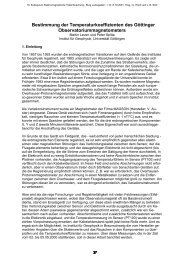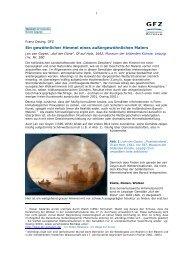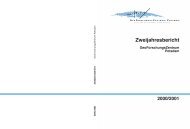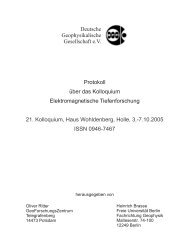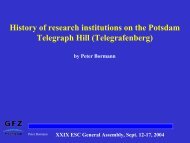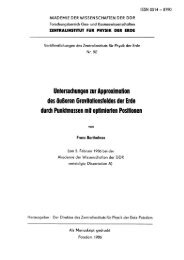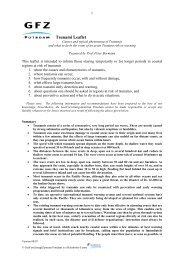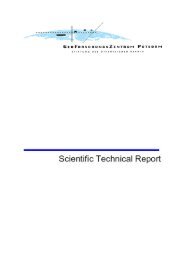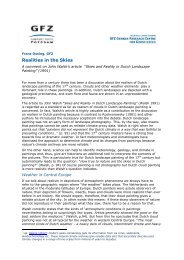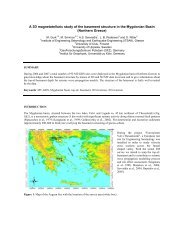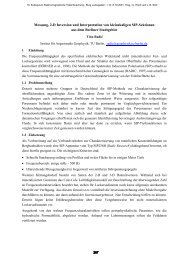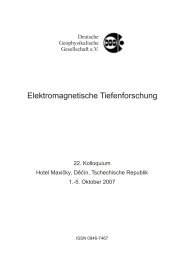Zweijahresbericht 2004/2005 - Bibliothek - GFZ
Zweijahresbericht 2004/2005 - Bibliothek - GFZ
Zweijahresbericht 2004/2005 - Bibliothek - GFZ
Sie wollen auch ein ePaper? Erhöhen Sie die Reichweite Ihrer Titel.
YUMPU macht aus Druck-PDFs automatisch weboptimierte ePaper, die Google liebt.
observatories Fürstenfeldbruck, Niemegk and Wingst,<br />
German repeat station data, and the available aeromagnetic<br />
and CHAMP satellite measurements have been considered.<br />
The results are detailed vector maps of the lithospheric<br />
geomagnetic field, with the large-scale information<br />
coming mainly from the satellite data and the smallscale<br />
information mainly from the aeromagnetic, combined<br />
with the observatory and in particular the denser repeat<br />
station measurements, to give the full vector description.<br />
External field<br />
The development of new analysis techniques for data from<br />
satellites and observatories permits an improved separation<br />
of the field sources into those which are internal and<br />
external to the Earth’s surface and also into those above<br />
and below the orbits where the satellite observations are<br />
made. Thus, in theory, the ionospheric sources which are<br />
external to the Earth’s surface but below the satellites'<br />
orbits, can be isolated. Such a separation allows for better<br />
parameterization of both the main geomagnetic field and<br />
the external variations which are modulated by solar activity.<br />
In the following example, both satellite and groundbased<br />
data is used for studying the ionospheric contribution<br />
in magnetic field measurements. The most intense<br />
current system in the ionosphere is that of the horizontally<br />
flowing auroral electrojet in the auroral oval.<br />
The strength and latitudinal position of these current<br />
flows depend on many factors, for example on the solar<br />
zenith angle, solar wind activity, magnetospheric convection<br />
and substorm processes. The characteristics of<br />
the auroral electrojet reflect the dynamics and the processes<br />
at the magnetopause and in the outer magnetosphere.<br />
The electric energy is transported from the magnetosphere<br />
to the ionosphere by currents flowing along<br />
the field lines. Their intensity controls the electric field<br />
and partially the state of ionospheric conductivity, and<br />
with it the strength and location of the auroral electrojet<br />
(Campbell, 1997). As an example, Fig. 14 shows the horizontal<br />
ionospheric current density computed from mag-<br />
netic field measurements taken onboard the CHAMP<br />
satellite (Ritter et al., <strong>2004</strong>) and from the IMAGE<br />
ground-based magnetometer network (Amm and Viljannen,<br />
1999). For this purpose total field data sampled by<br />
the Overhauser Magnetometer on CHAMP and the horizontal<br />
magnetic field measurements of the IMAGE network<br />
were used. The high correlation shown in Fig. 14<br />
demonstrates the capability of ground-based observations<br />
at high latitudes to predict the strength of the electrojet<br />
signatures in the satellite magnetic field scalar<br />
data.<br />
Conclusion and outlook<br />
Fig. 14: The auroral electrojet above Scandinavia obtained from intensity<br />
measurements on the CHAMP satellite and horizontal magnetic field measurements<br />
by the IMAGE network at the Earth’s surface.<br />
Der polare Elektrojet über Skandinavien, hergeleitet aus Messungen der<br />
Magnetfeldintensität des Satelliten CHAMP und Aufzeichnungen der horizontalen<br />
Magnetfeldkomponenten an den Stationen des IMAGE-Netzwerks<br />
am Erdboden.<br />
The Earth’s magnetic field is used for probing the Earth’s<br />
lithosphere and deep interior and understanding solar-terrestrial<br />
relationships; it is also a tool for navigation, directional<br />
drilling, geological studies and mineral exploration.<br />
The geomagnetic field is shielding our habitat from the<br />
direct influences of the solar wind, which becomes apparent<br />
during strong geomagnetic storms when the shield is<br />
pushed Earth-ward under the influence of the high-speed<br />
solar wind. Satellite failures, problems in telecommunication<br />
and radio transmission or even regional power failures<br />
are often encountered as consequences of them. To<br />
map the geomagnetic field and both its spatial and temporal<br />
variations, it is essential to improve our understanding<br />
of the different processes contributing to it and to<br />
increase the predictability of the future field evolution.<br />
Data from ground observatories, special surveys over land<br />
and sea, and from satellites must be jointly used to achieve<br />
these goals.<br />
The data gathered by geomagnetic observatories form the<br />
backbone in tracking continuously the magnetic field variations;<br />
their data are made available in a variety of time<br />
frames ranging from near real-time to 5-year summary<br />
information. <strong>GFZ</strong> is contributing to the worldwide observatory<br />
network with its central observatory in Niemegk,<br />
from where observatories in Wingst (Northern Germany),<br />
Bolivia, Bulgaria and Namibia are operated in cooperation<br />
with local institutions. Further cooperations with the<br />
aim of bringing more observatories to the INTERMAG-<br />
NET standard and filling other gaps in the<br />
global network are planned.<br />
During the last few years, three new<br />
satellites including <strong>GFZ</strong>’s CHAMP were<br />
launched by different agencies to measure<br />
the Earth’s magnetic field from<br />
space. Their data are made available by<br />
each of the mission data centres. For<br />
scientists, the biggest benefit of the highquality<br />
and huge amount of magnetic<br />
measurements, from ground and space,<br />
is a fresh point of view of the hidden interior<br />
of the planet, and its place in the<br />
magnetic solar system.<br />
Our magnetic planet will remain under<br />
observation with ESA’s forthcoming<br />
<strong>Zweijahresbericht</strong> <strong>2004</strong>/<strong>2005</strong> GeoForschungsZentrum Potsdam<br />
75



